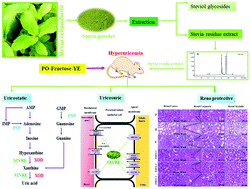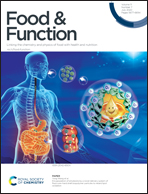Anti-hyperuricemic potential of stevia (Stevia rebaudiana Bertoni) residue extract in hyperuricemic mice†
Abstract
Hyperuricemia (HUA) is considered a potent risk factor for the development of gout, renal failure, and cardiovascular disease. The current project was designed to use stevia (Stevia rebaudiana Bertoni) byproduct, named stevia residue extract (STVRE), for the treatment of HUA. Male Kunming mice were divided into six groups: normal control, model control, positive control (allopurinol, 5 mg per kg body weight [bw]), STVRE-1 (75 mg per kg bw), STVRE-2 (150 mg per kg bw), and STVRE-3 (300 mg per kg bw). HUA was induced by the administration of potassium oxonate (100 mg per kg bw), fructose (10% w/v), and yeast extract (100 mg per kg bw) for 8 weeks. STVRE significantly (p < 0.05) decreased uric acid (UA) production and ameliorated UA excretion by interacting with urate transporters. The STVRE remarkably attenuated oxidative stress mediated by UA and downregulated inflammatory-related response markers such as COX-2, NF-κB, PGE2, IL-1β, and TNF-α. Furthermore, STVRE also reversed HUA-induced abnormalities in kidneys compared with the MC group. The results of our study suggest that STVRE has potential to attenuate hyperuricemia and renal protective effects, and may be used as a natural supplement for the possible treatment of UA-related disorders.



 Please wait while we load your content...
Please wait while we load your content...